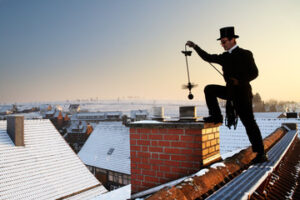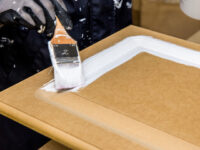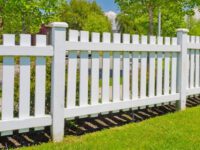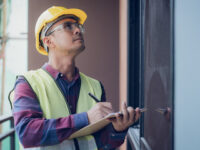What Does a Chimney Sweep Do?
Chimney sweeps use a variety of tools to remove blockages and creosote. Chimney Sweep also inspects and repairs damaged chimney components. Before your chimney sweep arrives, ensure your fireplace grate and firebox are empty. You must also clear the area within six feet of the fireplace opening.
 Chimney sweeps work above ground level and must always be aware of their surroundings. They also must wear proper clothing, including safety glasses and gloves, to avoid debris causing injuries. Likewise, they should use a face mask to prevent dust from entering their lungs while cleaning the interiors of chimneys. They should also consider using a sweeping cart to keep their hands free while working.
Chimney sweeps work above ground level and must always be aware of their surroundings. They also must wear proper clothing, including safety glasses and gloves, to avoid debris causing injuries. Likewise, they should use a face mask to prevent dust from entering their lungs while cleaning the interiors of chimneys. They should also consider using a sweeping cart to keep their hands free while working.
Chimney sweep tools include brushes and vacuum cleaners for removing soot, fireplace and chimney caps, spark arrestor installations, and specialized equipment to assess the internal integrity of the chimney system. This specialized equipment includes smoke-generating machines to detect a fire or leak, as well as drones and cameras that can navigate into spaces a human cannot enter. This enables the sweep to check for hazards and recommend any necessary repairs.
Many of today’s sweeps are certified by the CSIA (Chimney Sweeps International Association), and must pass rigorous testing to prove their knowledge of the fireplace, chimney and venting systems and codes and standards. The organization also holds members to a strict code of ethics and strives to protect homeowners from scams.
CSIA-certified sweeps will arrive at home inspections armed with the latest in technology. For example, Tom Urban, president of Estoban Corp, which makes the chimney-viewing system called SmartScan, says about one-third of sweeps use his device. It inserts into a common access point inside or on the roof and sends GPS-coded images to a mobile device used by the inspector.
If you suspect a sweep is trying to frighten you by showing you debris from your chimney that they claim indicates a broken liner, get another opinion. Similarly, if they mention carbon monoxide poisoning or house fires in a way that feels alarming, it could be a scare tactic to pressure you into making costly repairs.
A chimney sweep is a person who inspects and cleans fireplaces, flues and chimneys. This profession is regulated by the CSIA and NCSG, and members of these groups must adhere to strict ethical standards. Chimney sweeps use specialized brushes and rods to remove blockages and soot from the interior walls of a chimney, the flue, chimney cap and other components. They may also use a HEPA vacuum to suck up the debris.
Chimneys are often neglected, but a chimney that is properly cleaned and inspected can prevent carbon monoxide poisoning and chimney fires. Hiring a professional chimney sweep can save homeowners money, as they are able to identify potential problems and address them before they become serious issues.
The CSIA recommends that chimneys be swept at least once per year. This cleaning reduces creosote, which is highly flammable and the primary cause of chimney fires. It also ensures that the chimney is free of animals and debris. A sweep can spot warning signs such as ashy creosote chunks in the fireplace, broken chimney tiles on the roof and warped metal components such as a damper or chimney cap.
Depending on the chimney’s condition, an inspection and cleaning can take up to a few hours. Chimney sweeps usually work outside or on the roof and must wear insulated ladders, face masks and gloves to handle soot, creosote and other flammable materials. If the chimney is prone to leaks, a chimney sweep can repair cracks in the lining of the chimney or replace the chimney cap. In some cases, they can also make minor repairs to the fireplace or inserts. These repairs can increase the longevity of these appliances.
Chimney sweeps use a variety of flexible tools to clean chimney flues and fireplace structures. They may start from either the fireplace opening or the roof, depending on the type of work required.
A flexible tool kit includes a brush (the size and type of bristles depends on the flue type to be cleaned) attached to a rod, usually 3 feet long or one meter in old money). The chimney sweep pushes and retracts the brush inside the flue a number of times. This action allows the soot to be dislodged and fall down under gravity into the fire appliance below where it can be vacuumed away.
The chimney sweep may also use a chemical cleaner to remove creosote accumulation from airtight chimneys and other appliances. This process typically takes a few hours. It is important to have the proper chemicals and equipment to avoid contaminating the environment with hazardous substances.
It is important that a chimney sweep be flexible enough to move about a home. The chimney sweep may need to move furniture and cover floor areas. It is also important to be able to walk up and down stairs or in tight crawl spaces without the risk of repetitive use injuries.
Chimney sweeps must be able to identify the type of flue, whether brick or metal, and the condition of the flue walls. They must know the speed at which a power sweeping head should rotate to ensure that it does not damage the flue walls. The chimney sweep should also be able to adjust the power sweeping head height for optimum flexibility. This flexibility feature reduces the risk of damage to fragile linings and prevents overheating which can cause smoke back-up or other problems with the fire appliance.
Chimney sweeps spend a lot of time on ladders and rooftops. This can be dangerous if you’re not properly trained on ladder and roof safety and use the right PPE (personal protective equipment). Chimney sweeps should also be prepared to deal with any wildlife that may be living in a chimney that has been dormant for a long time. Creatures from raccoons to birds can make homes in chimneys, and they can be dangerous if they’re not safely removed.
During their inspection and cleaning, chimney sweeps scrape the coating from a chimney’s lining that is built up over many fires. This is called creosote, and it can cause a chimney to clog.
The chimney sweeps must also climb into the narrow flues that lead to fireplaces. During this process, the sweeps can be exposed to heat or carbon monoxide. Chimney sweeps of the 1700s were often children, who were vulnerable to being trapped or suffocating in the chimney. They were also prone to ischaemic heart disease, respiratory problems, and cancer. The job was so unpleasant and dangerous that laws were passed to regulate it.
If you’re considering hiring a chimney sweep, look for one who is certified by the CSIA. This will ensure that they follow local codes and are qualified to inspect, repair, and clean a chimney.
In addition to being well-trained on roof and ladder safety, a good chimney sweep will be fully insured. This is important because chimney sweeps can be held responsible for injuries that occur on your property. They should also have enough liability insurance to cover the cost of any repairs that they recommend. In addition, they should be able to provide proof of their insurance coverage upon request.
Many homeowners hire a chimney sweep to clean their fireplaces and chimneys. They do this to ensure their chimney is safe to use, and can detect any underlying problems before they become worse. A chimney is meant to carry away any harmful contaminants and carbon monoxide generated by a fire, but can’t do this job if it’s clogged with debris or has other issues that need fixing.
A chimney sweep works as a self-employed contractor and can set his or her own hours. This can be a very flexible career, which can also be very lucrative if the right business structure is chosen. Many chimney sweeps opt to be a sole proprietorship, while others choose to organize as a partnership or limited liability corporation.
Chimney sweeps typically work for residential homeowners and small to medium-sized commercial properties. They are often highly trained in detecting any problems with a chimney, including cracks and leaks, and can provide valuable advice on how to avoid dangerous situations. They may also recommend services to make the chimney more efficient, or suggest upgrades to increase safety and energy savings.
Most chimney sweeps are certified by the National Chimney Sweep Guild (NCSG) or the Chimney Safety Institute of America (CSIA). These organizations hold their members to high professional standards and conduct regular training programs. Additionally, most sweeps are insured to protect themselves and their clients from liability issues. They may also be required to have a home improvement license for any repair work they perform. This helps to separate personal and business expenses, which can help with tax filing. For this reason, it’s important to keep accurate records of all business expenses.






